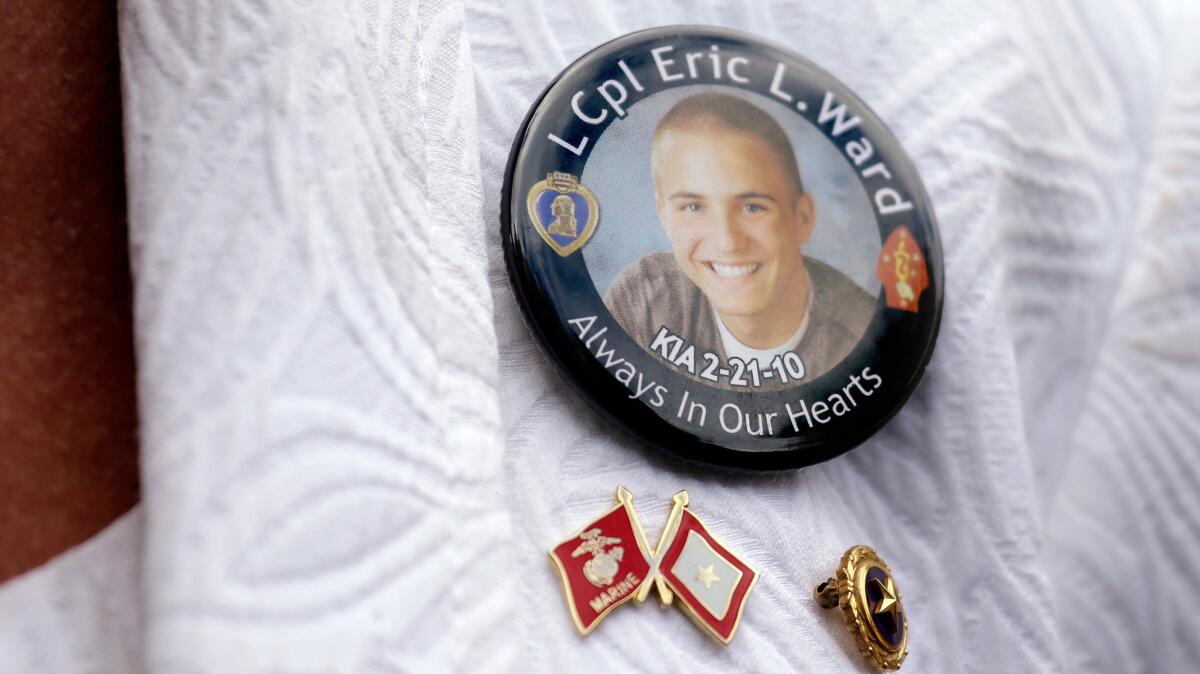How a gold star became a symbol of the ultimate sacrifice
- Share via
It’s been a symbol of honor that no one wants.
The gold star denoting a family member who died in combat dates back to World War I, but before last week, the phrase “Gold Star family” wasn’t as widely known as it was during World War II.
Then came the controversy surrounding Donald Trump and Khizr and Ghazala Khan, who lost a son, Army Capt. Humayun Khan, to a suicide bomb in Iraq in 2004. Khizr Khan, speaking at the Democratic National Convention, challenged Trump’s policies, saying, “You have sacrificed nothing and no one.”
After Trump lashed out at the Khans, the Veterans of Foreign Wars was among the many who came to their defense, with VFW President Brian Duffy saying, “Election year or not, the VFW will not tolerate anyone berating a Gold Star family member for exercising his or her right of speech or expression.”

“There are certain sacrosanct subjects that no amount of wordsmithing can repair once crossed,” Duffy said.
Arizona Sen. John McCain, in a statement released Monday, said Humayun Khan exemplified the best of America. “Captain Humayun Khan of the United States Army showed in his final moments that he was filled and motivated by this love,” McCain said. “His name will live forever in American memory, as an example of true American greatness.”
But how did the gold star become a symbol of the ultimate sacrifice?
During World War I, a practice developed across the country: Families displayed flags featuring a blue star, a sign that a family member was fighting in the war. Some flags would display more than one star.
Just how the next tradition began is unclear, but when a soldier died, the blue star was replaced by a gold one.
In 1918, President Woodrow Wilson approved a recommendation by the Women’s Committee of National Defenses to wear a black armband with a gold star — an update on traditional signs of mourning. It’s believed Wilson coined the term “Gold Star Mother.”
Over time, two types of service flags were created. One banner had a white background, red border and blue star. The other had a white background, blue border and gold star.
In 1928, 25 mothers met in Washington, D.C., to establish a national organization called American Gold Star Mothers Inc. That organization exists to this day.
In 1947, Congress authorized the military to issue gold star lapel pins to families of those who had been killed in combat. In 1973, Congress approved another for families of service members who died while on active duty but not in combat.
During World War II, the star flags were common sights across the country, often displayed in windows. That changed during the Vietnam War. During that unpopular conflict, when many Americans associated soldiers with government policies, many saw little value in displaying a blue or gold star flag.
Those attitudes have changed in recent years.
“It’s been a slow build to get it’s respect back,” said Richard Parker, a public policy lecturer at Harvard’s John F. Kennedy School of Government. “But there was a dissociation within the American public. They were disillusioned with the military after Vietnam.”
Parker credited Army Gen. Creighton Abrams, a prominent commander during the Vietnam War, with helping to restore the military’s reputation, especially as it moved away from the hugely unpopular draft of the Vietnam era.
“He used the fact that the military had converted to all-volunteer forces to gain some public favor,” Parker said.
After Abrams, Gen. Colin Powell’s support of President George H. W. Bush’s “Operation Desert Storm” caused the military’s approval rating to soar, he said.
The terrorist attacks of Sept. 11, 2001, further enhanced the military’s standing, prompting many Americans to enlist in the armed forces.
See the most-read stories this hour »
Although the practice of displaying blue and gold stars has been revived since the wars in Iraq and Afghanistan, the images still remain a mystery to some.
The Republican Party in North Carolina sent out a tweet last week criticizing Virginia Sen. Tim Kaine for wearing what it said was a lapel pin of the Honduran flag when he accepted the Democratic Party’s nomination for vice president. As a young man, Kaine spent a year as a missionary in Honduras, and the tweet called his flag pin shameful.
Actually, Kaine was wearing a blue flag pin to acknowledge his son, a Marine. The North Carolina GOP later apologized.
The widow of one serviceman once said she wished more Americans appreciated the meaning of the gold star. Donna Engeman lost her husband, Chief Warrant Officer John Engeman, in 2006 while he was stationed in Baghdad. In 2011 she told an interviewer with the U.S. Army that more needed to be done to educate people on the meaning of the gold star.
“It’s disheartening to be so far into this war,” she said, “yet when I drive around with a bumper sticker and pin and people just don’t know.”
Twitter: @alexiafedz
ALSO
The Khan family’s road to confrontation with Donald Trump
How Trump supporters are pushing back against the Khan controversy
Veterans group chastises Trump for attacks on fallen soldier’s parents
More to Read
Sign up for Essential California
The most important California stories and recommendations in your inbox every morning.
You may occasionally receive promotional content from the Los Angeles Times.













